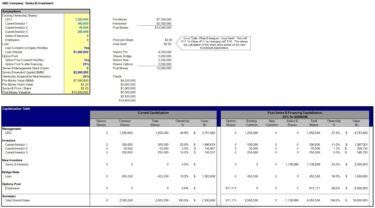What is Liquidation Preference?
A Liquidation Preference represents the amount the company must pay to the preferred investors at the exit, after secured debt and trade creditors.

Liquidation Preference Definition
A liquidation preference represents the amount the company must pay at exit (after secured debt, trade creditors, and other company obligations) to the preferred investors.
In effect, the downside risk of preferred investors is protected.
The investor is provided with the option, in a liquidity event, of either:
- Receiving their preferred return as originally stated
- (or) Converting into common shares and receiving their percentage ownership as their return
The order of liquidation and priority are some of the most important terms to look out for in a VC term sheet, as they significantly impact returns and how the capitalization table is modeled.
The two most common types of liquidation preference structures in venture capital (VC) are:
- Non-Participating Preference
- Participating Liquidation Preference
Non-Participating Preference
- Commonly referred to as “straight preferred”
- Liquidation Preference = Investment * Liquidation Pref. Multiple
- Will involve a multiple such as 1.0x or 2.0x
Participating Liquidation Preference
- Commonly referred to as “participating preferred”, “full participating preferred”, or “participating preferred with no cap”
- In this structure, investors first receive their liquidation preference and then share in the remaining proceeds on a pro rata basis (i.e. “double-dipping”)
- Capped Participation:
- Commonly referred to as “capped participating preferred”
- Capped participation indicates that the investor will share in the liquidation proceeds on a pro rata basis until total proceeds reach a certain multiple of the original investment
Liquidation Preference Calculation Example
Suppose that there are four potential outcomes for an investor investing $1 million for 25% of a company that later sells for $2 million:
Outcome #1: No Liquidation Preference
- Investors get only $500,000 (25% of proceeds), losing half of their capital, while the common shareholders receive $1.5 million.
Outcome #2: Non-Participating at 1.0x Liquidation Preference
- Investors would get $1 million from their 1.0x preference, with common getting the remaining $1 million.
Outcome #3: Participating 1.0x Liquidation Preference
- Preferred investors get $1 million off the top plus another $250,000 (25% of the remaining $1 million).
- The common shareholders would receive $750,000.
Outcome #4: Participating 1.0x Liquidation Preference with 2x Cap
- Preferred investors get $1 million off the top plus another $250,000 (cap does not go into effect).

Everything You Need To Master Financial Modeling
Enroll in The Premium Package: Learn Financial Statement Modeling, DCF, M&A, LBO and Comps. The same training program used at top investment banks.
Enroll Today





